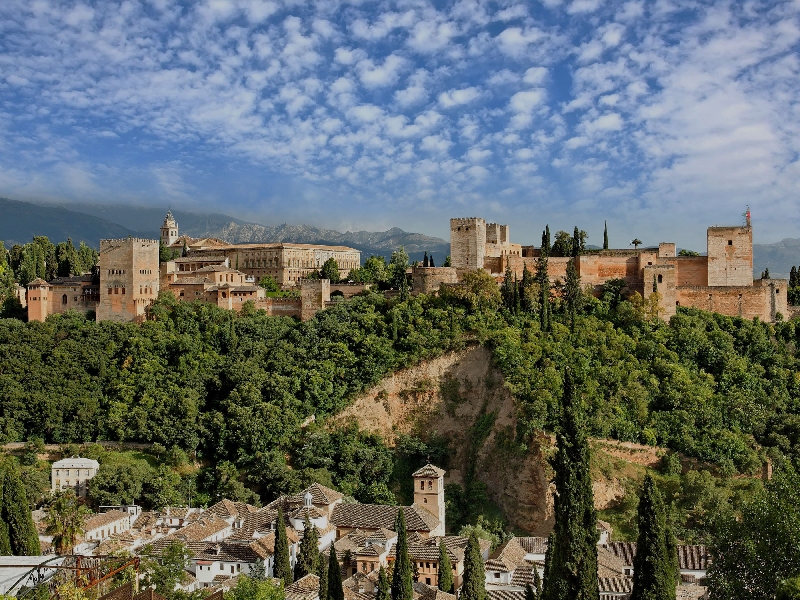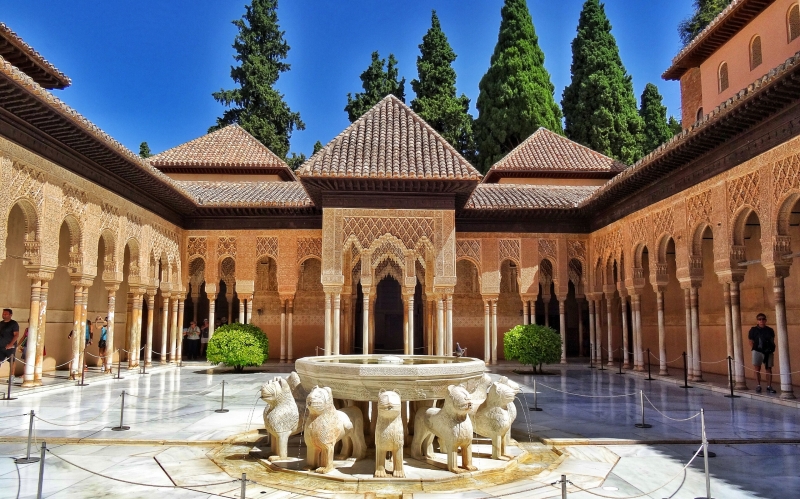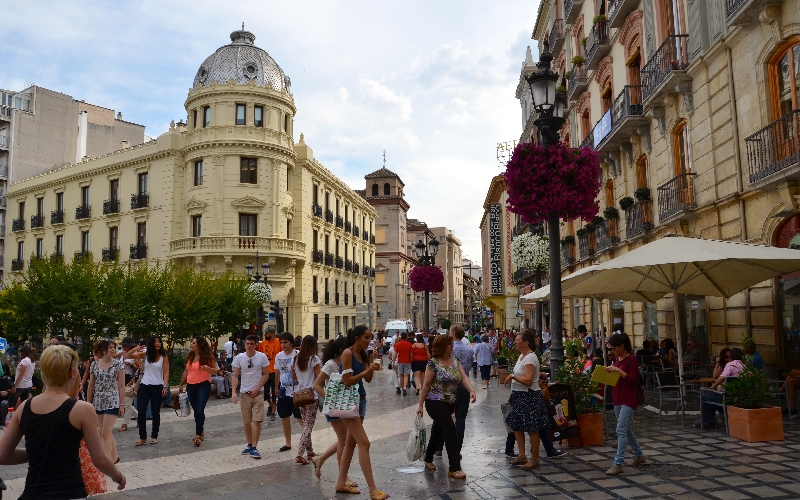FINE ART FOR INTERIOR DESIGN

Granada has a rich and complicated history. It originated as an Iberian settlement under Ancient Roman rule. When the Roman Empire fell, Visigoths maintained it as a military hub. In 711, Muslim forces captured Granada and brought Islamic law to the Iberian Peninsula. After the fall of Cordoba in 1236, Muslims sought refuge in Granada, and the city became the capital of an independent emirate. For the next 250 years, Granada existed as one of the wealthiest cities in medieval Europe, and it was the heart of a formidable kingdom. In the late 15th century, the Christian Reconquista led a military campaign against Granada, and in 1492, the king was forced to surrender the city. Following the Reconquista, religious persecution took its toll, and Granada fell into a deep decline. It wasn't until the late 19th century that the city began to rebuild and modernize.
Granada has a rich and complicated history. It originated as an Iberian settlement under Ancient Roman rule. When the Roman Empire fell, Visigoths maintained it as a military hub. In 711, Muslim... Read More

The Alhambra is a palace and fortress known in Arabic as the Red Castle. It's located to the west of Granada, on top of the hill al-Sabika. Built in 889 as a small fortress, it was renovated in the 13th and 14th centuries and reconstructed as a palace and fortress complex. In 1333, the Sultan of Granada converted it into a royal palace. The Patio de Los Leones is one of the most famous courtyards in the Alhambra. Built-in the late-14th century, it's named after the marble fountain that channels water through twelve lions, which stands at its center. An Arabic poem is engraved along the border of the fountain, and it's an important symbol of Muslim sculpture. After the Reconquista, Catholic Monarchs ordered the destruction of the Alhambra. The mosque was replaced with a cathedral, and part of the complex was destroyed to accommodate Renaissance art.
The Alhambra is a palace and fortress known in Arabic as the Red Castle. It's located to the west of Granada, on top of the hill al-Sabika. Built in 889 as a small fortress, it was renovated in the... Read More

The Alhambra is an ode to Moorish culture and medieval architecture overlooking the city of Granada. Rich in history and beauty, it's an important tourist destination for anyone visiting the area. The Alhambra houses three royal palaces surrounded by ornately designed gardens and courtyards. Each room contains ancient artifacts, intricately carved walls and ceilings, and multicolored paintings. The complex is also home to two museums, which display Islamic relics and Christian art.
The Alhambra is an ode to Moorish culture and medieval architecture overlooking the city of Granada. Rich in history and beauty, it's an important tourist destination for anyone visiting the... Read More

Calle Caldereria Nueva is a Middle Eastern street in Granada known for its exotic shops and teahouses that bring Moorish culture to life.rnSituated below the Alhambra, Calle Caldereria Nueva contains an eclectic mix of family shops and bazaars. It's known for its hookahs, North African pottery, and jewelry. It is the perfect place to try a delicious cup of traditional Moroccan mint tea.
Calle Caldereria Nueva is a Middle Eastern street in Granada known for its exotic shops and teahouses that bring Moorish culture to life.rnSituated below the Alhambra, Calle Caldereria Nueva contains... Read More

Granada is a tranquil city in Southern Spain. Located at the foot of the Sierra Nevada Mountains, it's filled with Arab influences and medieval architecture. Apart from the Alhambra and Calle Caldereria Nueva, Granada is also home to Mirador San Nicolas, a lookout with sweeping views of the Sierra Nevada that is widely considered to be one of the best viewpoints in all of Spain. Granada was a Muslim Kingdom for hundreds of years, and it stands today as a symbol of Spain's Islamic past. It's the home of Moorish-era culture. The city is filled with hidden gardens, ancient Arab buildings and sculptures, traditional Arab cuisine, and a royal palace, which remains a preeminent symbol of Muslim art, culture, and history. The city has unbeatable views of the snow-capped peaks of the Sierra Nevada and is an incomparable travel destination well worth the trek.
Granada is a tranquil city in Southern Spain. Located at the foot of the Sierra Nevada Mountains, it's filled with Arab influences and medieval architecture. Apart from the Alhambra and Calle... Read More
.png)
.jpg)
.jpg)
.jpg)
.jpg)
Italian master chef, Fulvio Pierangelini's Tuscan Bistro, is located in the Hotel Savoy and firmly...
George Clooney, Rande Gerber, and Mike Meldman, the three amigos, really love drinking tequila, so...
As the founder of one of the most famous clubs in the world, Steve Rubell was known to celebrities...
The alluring magnificence of the Roaring '20s is personified within the enchanted walls of Hearst...
The Alhambra: Rich in History and CultureBy: Daniel Evon / Photographs Courtesy of The Alhambra |

|
|
Granada has a rich and complicated history. It originated as an Iberian settlement under Ancient Roman rule. When the Roman Empire fell, Visigoths maintained it as a military hub. In 711, Muslim forces captured Granada and brought Islamic law to the Iberian Peninsula. After the fall of Cordoba in 1236, Muslims sought refuge in Granada, and the city became the capital of an independent emirate. For the next 250 years, Granada existed as one of the wealthiest cities in medieval Europe, and it was the heart of a formidable kingdom. In the late 15th century, the Christian Reconquista led a military campaign against Granada, and in 1492, the king was forced to surrender the city. Following the Reconquista, religious persecution took its toll, and Granada fell into a deep decline. It wasn\'t until the late 19th century that the city began to rebuild and modernize. |

|
|
The Alhambra is a palace and fortress known in Arabic as the Red Castle. It's located to the west of Granada, on top of the hill al-Sabika. Built in 889 as a small fortress, it was renovated in the 13th and 14th centuries and reconstructed as a palace and fortress complex. In 1333, the Sultan of Granada converted it into a royal palace. The Patio de Los Leones is one of the most famous courtyards in the Alhambra. Built-in the late-14th century, it's named after the marble fountain that channels water through twelve lions, which stands at its center. An Arabic poem is engraved along the border of the fountain, and it's an important symbol of Muslim sculpture. After the Reconquista, Catholic Monarchs ordered the destruction of the Alhambra. The mosque was replaced with a cathedral, and part of the complex was destroyed to accommodate Renaissance art. |

|
|
The Alhambra is an ode to Moorish culture and medieval architecture overlooking the city of Granada. Rich in history and beauty, it's an important tourist destination for anyone visiting the area. The Alhambra houses three royal palaces surrounded by ornately designed gardens and courtyards. Each room contains ancient artifacts, intricately carved walls and ceilings, and multicolored paintings. The complex is also home to two museums, which display Islamic relics and Christian art. |

|
|
Calle Caldereria Nueva is a Middle Eastern street in Granada known for its exotic shops and teahouses that bring Moorish culture to life.rnSituated below the Alhambra, Calle Caldereria Nueva contains an eclectic mix of family shops and bazaars. It\'s known for its hookahs, North African pottery, and jewelry. It is the perfect place to try a delicious cup of traditional Moroccan mint tea. |

|
|
Granada is a tranquil city in Southern Spain. Located at the foot of the Sierra Nevada Mountains, it\'s filled with Arab influences and medieval architecture. Apart from the Alhambra and Calle Caldereria Nueva, Granada is also home to Mirador San Nicolas, a lookout with sweeping views of the Sierra Nevada that is widely considered to be one of the best viewpoints in all of Spain. Granada was a Muslim Kingdom for hundreds of years, and it stands today as a symbol of Spain\'s Islamic past. It\'s the home of Moorish-era culture. The city is filled with hidden gardens, ancient Arab buildings and sculptures, traditional Arab cuisine, and a royal palace, which remains a preeminent symbol of Muslim art, culture, and history. The city has unbeatable views of the snow-capped peaks of the Sierra Nevada and is an incomparable travel destination well worth the trek. |